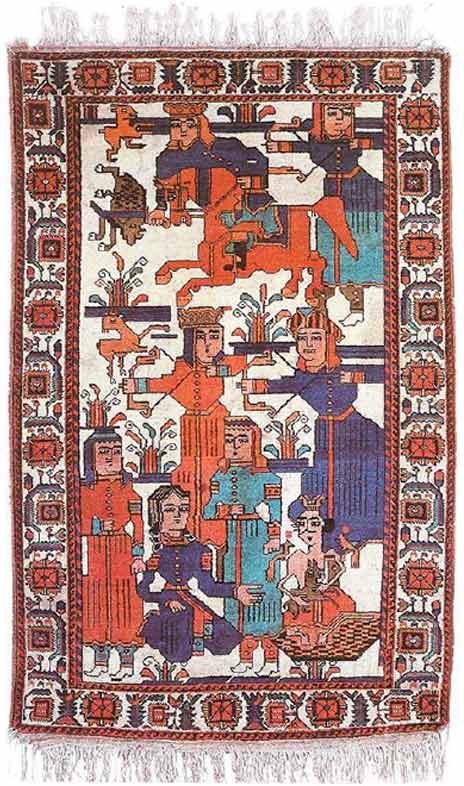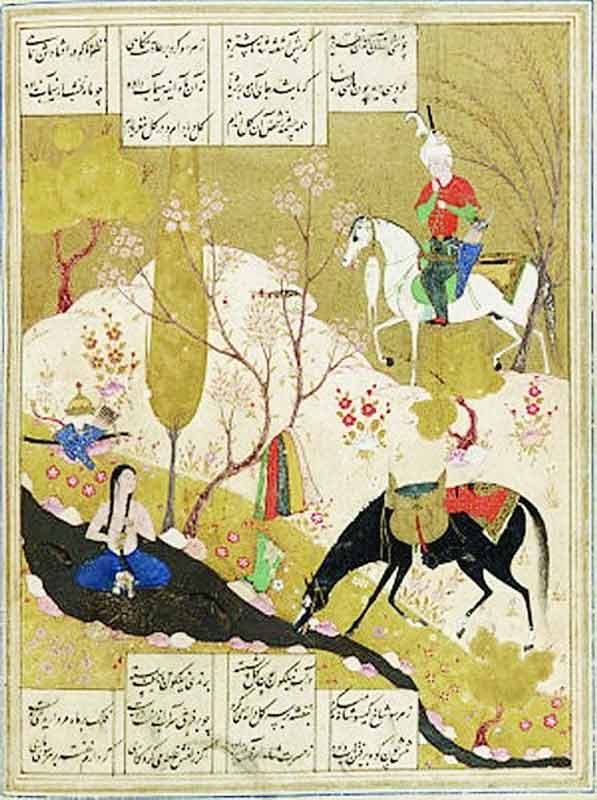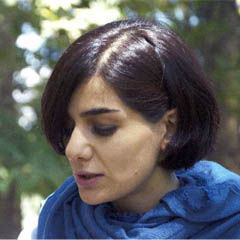A carpet is neither produced nor read like other pictures. As such, how does it communicate and what is the proper way of reading a carpet? Does it enjoy an esoteric meaning? A meaning beyond that of its patterns? In other words: is the carpet a decorative object with a symbolic or iconic meaning added on top, or does it contain—at least for viewer who belongs to Persian visual culture—a meaning completely different from any other quotidian object? The mesmerizing power of the carpet lies in the fact that it convinces the viewer of the latter. Many studies on the subject aim at understanding how different Persian carpets are made, trying to elucidate the nature of their mode of production. Yet, “how the appearance is consumed”[1] has rarely been the subject of study, as well as inquiring about the causes behind the formation of such a bizarre appearance. It can easily be shown that the answer cannot be reduced to how a carpet is produced: it is clear that Persian carpets are more than, as it were, a pixelated version of Persian images found in other Persian decorative arts, or the product of a “design process” (as one understands the term today) and sheer creativity; it is rather an object unlike any other quotidian objects and not just another branch of fine or decorative arts.
It is very difficult to penetrate the different layers of meaning in a Persian carpet, at least much more so than Persian miniature paintings for example there is a winding path from form to meaning in carpets. A Persian carpet has something to say that is not a statement: it is not a text with a definitive meaning, not even one that we could call “abstract” in the sense of avoiding any reference to the real world. Similar to mystic verses of Sufis, known as shat-hiyyāt, whose general meaning is unclear to the reader, yet written down, with meaningful words, for a purpose clear to the author, the appearance of carpets insists on signifying something: they are not just pleasant melodies without words. As such, the carpet cannot be studied as an abstract painting. (Probably that is why it has rarely inspired modern Persian paintings and protects itself against easy visual plagiarism.) The image of a carpet is not the same as the carpet itself: the carpet is not produced to be “seen”, rather be “watched” in the long term. It is meant to be lived on, not to be distanced from the viewer to produce a moment of reflection, which is the essence of European painting. It is not an exaggeration to say that every Iranian grows up on a carpet and learns visual literacy from it. It is the very first window through which every Iranian look. The opposite of a Renaissance painting, i.e. a window opening to the outside world, is the carpet, not even the Persian miniature painting.
Despite its decorative function, the effect of Persian carpets, and in particular pictorial Persian carpets, on viewers do not depend on the text that accompanies it (as is the case with urban, fictional, pictorial carpets[2] and Persian painting alike). The origins of pictorial carpet have been, as it follows, purely aesthetical, nothing more.
Historically, pictorial carpets appeared as new art, not only because of a change in their function but also because of their new appearance[3]. They were woven according to the personal taste of weavers or specific clients, and for that reason, they were less mass-produced. There is no doubt that such carpets as Persian miniatures are ultimately born of the poverty of illustration[4] in Iran. Such carpets, also known as figural carpets, “emerged in the late twelfth century AH (18th century AD) following developments in various other fields of art in Iran and coincided with the emergence of new possibilities in the visual realm, such as printed pictures or photographs. All these led to a new expression in Persian carpet weaving.” (Tanavoli, 1989:9) The story narrations in the pictorial carpets of Iran have different origins. Themes of pictorial carpets include kings, epic and romance stories from classical Persian literature, religious themes and stories of Quran, dervish and Sufism, Armenians pictorial carpets, nomads’ pictorial carpets, pretty women, and animals.
In order to enter the realm of the Persian carpet, let us begin from a simpler point of departure. We ask: what is the relationship of the carpet to the space in which it is unrolled? What is the horizon of the carpet and what is space and time in the carpet? The objective form of such a relationship is reflected in the relation between the carpet and the architectural space. Of course, we have samples of carpets woven for a particular space, as well as spaces built to house a particular carpet. We know, for example, that Nasser al-Din Shah (who reigned from 1848 to 1896) ordered a complete building to be fitted with a carpet he received as a present from the Ottoman sultan. Mo’ayer al-Mamālek writes: “Abyaz Palace: Although the building is still in place, not everybody knows why it was built, therefore, some facts are mentioned here. Sultan Abdul Hamid sent dozens of pieces of furniture and some precious Turkish carpets to Nasser al-Din Shah. Several large portraits of European kings and queens painted by the most influential painters of the era were also given to Nasser al-Din Shah. As other palaces were all decorated with various ornaments and were not suitable for the aforementioned gifts, so the king ordered the Abyaz palace to be built and tailored to the size of the largest Ottoman carpet. When it was finished, they unrolled the carpet in the hall and decorated the space with precious upholstery. They hung the portraits together with another painting depicting Napoleon I, given to Fat’h Ali Shah, thus creating a magnificent hall for receiving kings and dignified guests. One day I was there when the king went to the treasury, and there he chose some artifacts to complete the arrangement of the Abyaz palace.”
The visual significance of the Persian carpet must be considered as Iranians’ historical understanding of art and painting as an independent language, and pictorial carpets can perhaps be formulated as a new form of testimony to such a language. The language begins with the synchronicity of Persian painting with literature and fiction texts and its culmination in the pictorial carpet. Persian painting is considered narrative art. “Because some example of Persian painting is an illustrated book that depicts a literary text, most of which are fiction.” (Shokrpour, Azhari, 2019:104) In Persian painting, the drawings depend on the text “and this feature is one of the main features of the illustrations of Shahnameh, which includes short and concise themes in which the narrative aspect lies. These texts were chosen for illustration because their readers were fully acquainted with the leading text, allowing the painter to show the last minutes of the events and the most notable or most tragic moments in his work.” (Shokrpour, Azhari, 2019:104) The logic of the carpet, however, is much more complex than painting. The charm and wonder of the pictorial carpet stem from the middle point between the carpet and painting, where the story originates, and which, of course, has become “inexpressible.” Neither the image nor the story is a reality of this world; just like the miniature, pictorial carpet is also an imaginary window to stories; no event or thing in that frame has a real presence. They are pure images (without any text) that create a suspended and immaterial world of colors, shapes, and textures. Pictorial carpet is a unity resulting from the contradictions between the common presence of figural pictures and details of carpet designs. That is why the carpet frame and its details have added to its grace and appeal rather than reducing the magical attractiveness. The “childish” aspect of such images, which are not solely due to the weaver's inability to render everything realistic, is a result of a vast game of imagination combined with pictures.
What is unique in the pictorial carpet is the magical aspect, and the subject of the painting is completely insignificant. Of course, in harmony with the scene, each picture has its own special figural drawing and necessities in terms of color combination. (The color combination is insignificant in nomadic and rural pictorial carpets. For example, the skin color of the body could be very strange, e.g., red, etc.). But whatever the image is, whether romantic like countless scenes of Shirin bathing with Khosrow secretly watching her or battle scenes, such as the battle of Rostam and Sohrāb, the shocking effect of the pictorial carpet is the same in each case.
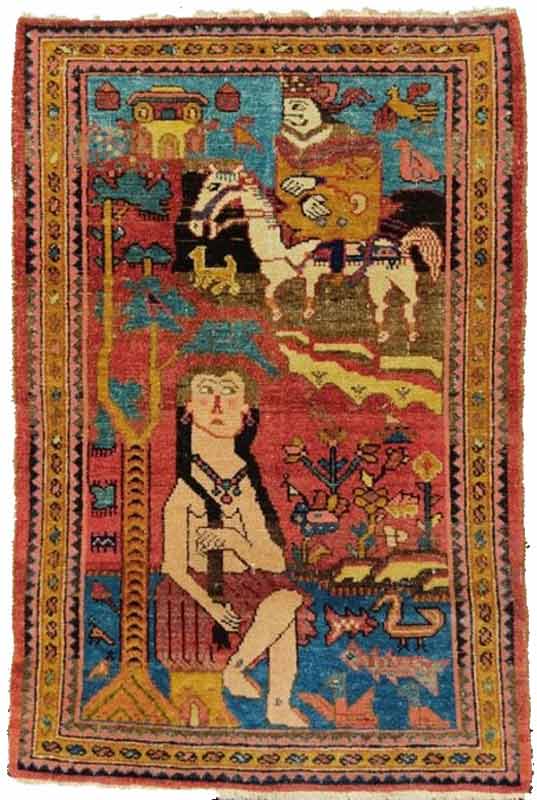
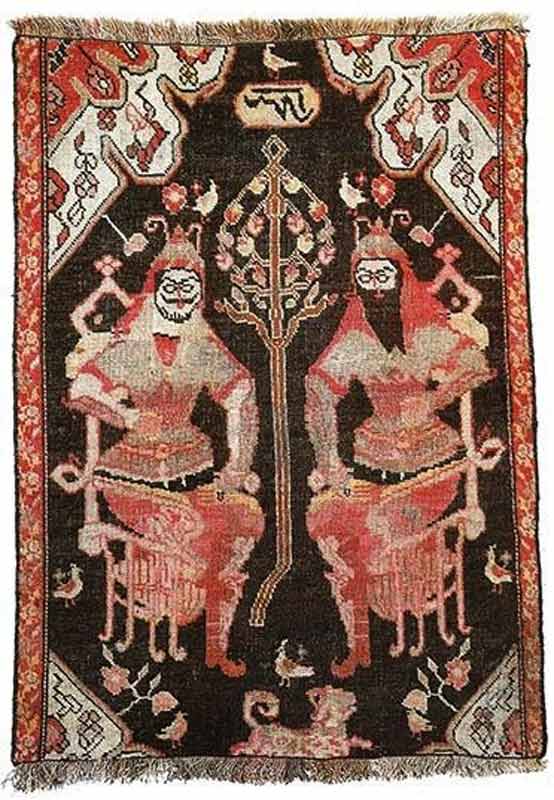
Figure 4: Lilihan Poshti. The story of Khosrow and Shirin. Natural color, size 100*67 cm, Yousef Samadi Bahrami’s Collection.
Figure 5: Rostam and Sohrab, Karabakh (South Caucasus), inscription reads: “Sohrab” (inverted text), late 13th century AH, 120*85 cm, asymmetric knot, displaying 672 knots per square decimeter (Tanavoli 1989, 43) When the carpet depicts a story, it does not narrate it.
A pictorial carpet is not really depicting the place of an event or the feeling or interpretation of what happened in the scene. Apart from the feeling of wonder at the visual beauty reflected in the carpet, there is nothing but a thoughtful or emotional expression: there is no drama, no sadness or sense of impression. The event as a whole is an absent element in the pictorial carpet. All details are equally important; thus, the important function of a pictorial carpet is that it guides the viewer's gaze on numerous details of the carpet, while an inner harmony skillfully creates a strong, decorative unity. Such carpets attract viewers’ attention, not because the scene is a special story that is unsuccessful in its narration, but in the harmony with the story figures within the form of a carpet.
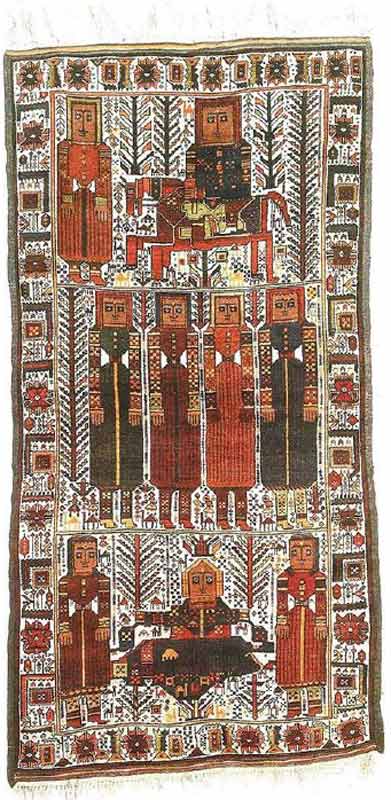
Figure 6: Baluch, Zabol, mid-14th AH century, asymmetric knot, 1280 knots per square decimetre; this carpet displays a scene from the story of Khosrow and Shirin. However, the images in the carpet do not narrative anything and if the viewer is unfamiliar with the story there is little to be understood from the images. (Tanavoli 1989, 48)
Of course, the carpet, in its physical aspect, has a distinctive relation to space in Persian architecture, as it covers a rectangular space that shall not deflect both horizontally and vertically. It is true that the carpet was not always considered a floor covering and not necessarily been rectangular in shape: as in the case of saddlebags and cushions, or carpets hanging from walls or covering a horse or a mule, and so on. Yet it is the Persian architectural space that provides a flat, rectangular space for the carpet: it is part of the formal relationship of carpets with the architectural space. This is why in European paintings that feature a Persian carpet, the first thing that strikes an Iranian viewer is the unusual use of these carpets: Hung from a window crawled up the stairs and deflected in height. This, in itself, has a definite relation to the way the carpet is seen: on the one hand, the formal carpet looks like a horizontal tableau that is clearly framed and as such forms a totality. It does not resemble, for example, the scattered Islamic designs on glazed tiles that crawl up walls whose entirety forms the totality of the building; on the contrary, the carpet has a strong, coherent framing that protects it against any deflection.
In the past, Persian carpets were not masked by pieces of furniture and thus better seen in their entirety. The carpet was the most important part of interior design. It was a furniture in itself. Thus, the carpet is fundamentally different from a painting: viewers of a carpet never actually see it in its entirety because they are already standing “on” the carpet. They never lose contact with it or distance themselves from it, far enough to see it in its entirety. They can kneel and touch it, or sit or lie down on it and get closer to it as much as they want, but their distance to the carpet never exceeds their height. The prohibition of walking on carpets with footwear allows a close and intimate relationship with the carpet, emphasizing its dignity and sanctity. Even paintings on ceilings (which sometimes reflect the patterns of a carpet, as in the case of Sheikh Safi’s tomb) do not enjoy such quality and can be seen and appreciated in one glance while remaining out of viewers’ reach. In the case of carpets, viewers can see the design from different angles and need to move in space and change their standpoint to fully appreciate the work (exactly the same way they need to circulate within the introverted spaces of Persian architecture in order to grasp a proper sense of space).
It might seem that the distance between the carpet and the observer is a secondary quality of the carpet and does not have a direct impact on the aesthetic aspect of the Persian carpet. However, we know of aesthetic systems (including that of Kant) that define the aesthetic experience fundamentally on the basis of an idea of distance. The most prominent is that of Edward Bullough (1880-1934), the English aestheticist, i.e. Psychical Distance. In a paper published in 1912, Bullough writes that the aesthetic experience takes place at a certain distance from the work, not too far nor too close, and this applies to the locative, temporal, and subjective distance of the observer from the object, and is an aesthetic principle (Neil 1995, 304), and is an element present in all art forms (ibid., 299). The transition from the agreeable to the beautiful takes place through distance (Neil 1995, 305). And it is advisable to reduce this distance both in creating and in understanding art, without having it completely removed. (Neil 1995, 302) In his view, this depends both on the audience and the object (Neil 1995, 302). For instance, the Persian miniature takes advantage of its small dimensions to reduce such distance. In carpets, however, the distance is completely different, both objectively and subjectively. The maximum distance is a person’s height and the minimum is zero. It is this distance that has resulted in the unique form of viewing carpets. The Persian carpet is not seen, but “watched” (tamāshā), as was the case with Persian gardens. That is to say, carpets were observed in motion, with a constant shift of the viewer’s point of view. The term tamāshā means “to watch” and “to walk in the garden with a friend” at the same time. Such a relationship between how carpets and gardens are viewed is by no means a coincidence. Persian carpets have long been associated with Persian gardens, sometimes even reflecting and imitating their patterns. In terms of function, the Persian carpet brings nature into the interior and plays the role of green in times of the year when grass does not grow. We know that the famous Sassanid “Baharestan” carpet had a similar function. Tabari History writes about this carpet:
“They wove a carpet with colored silk, sixty cubits in sixty cubits … they unrolled it in wintertime when no flowers blossomed and no green was seen on the globe. On the margins were sown emeralds and peridots… Omar ripped the carpet and the gems and gave each person a fair share… Ali ibn Abi Talib received his, which he sold for twenty thousand Dirhams.” (Tabari History, 1985, 41).
Thus, we encounter one of the most important subjective aspects of the relationship between carpets and architecture: the viewer is a part of the image; the observer of a carpet is “inside” the carpet. This also properly explains the horizon line in Persian carpets, which is very different from that of miniature painting: the carpet does not necessarily have a horizon line, and the horizon line is not necessarily within the carpet or in its “upper” part. The figures in pictorial carpets are not depicted “on” the carpet but are rather “inside” the carpet, like a letter in an envelope.
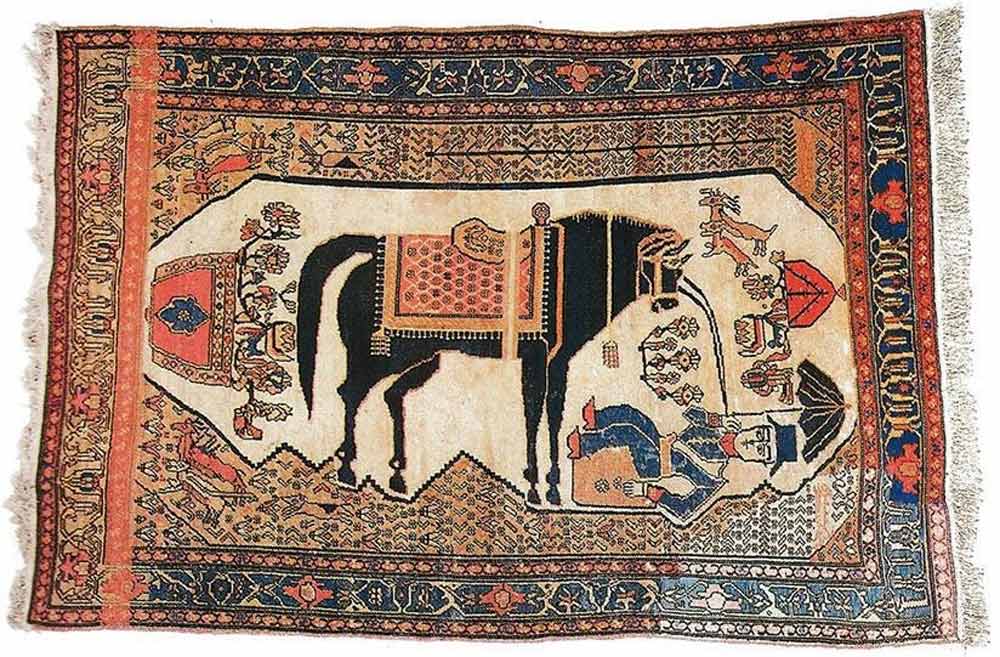
Figure 7: Horse and stableman, Hamedan, Darjazin, early 14th Century AH, 189*129 cm, symmetrical knot, 1296 knots per square decimeter (Tanavoli 1989, 95). The logic of the carpet design is much more bizarre than miniature. Where is the horizon line in this carpet?
This statement is also true on another level: the observer is “within” the carpet subjectively too. The carpet is not a home decoration, it is part of the home: it is home itself. This is why the unit for counting carpets, was called “home” (khāneh), or why the carpet sometimes imitates the plan of the Persian houses or gardens. Children are well enough familiar with this concept and elders respect it too. Children carefully trying to walk on the lines of a carpet pattern imagine themselves walking on a bridge above avoid. The patterns of a Persian carpet always show depth, as opposed to Persian miniature painting which appears flat and even.
So, when confronted with carpets, even pictorial ones, “touching” is more important than “seeing”. In fact, this is the only way to see it. Touching renders, us more dominant. Seeing does not allow one to understand the physical quality of a phenomenon, but the tactile sensation does. In pictorial carpets, this touching proximity is more realistic than an unattainable distance, as it empowers the viewer to touch the universe once again. The carpet is a representation of the universe, as the root of the Persian term indicates: in Haji/Engineer Travelogue, Ali Hassouri traces the root of the word Qāli (carpet), back to Qalin in the early Islamic centuries, to the words Kalinin the Sassanid era and Kar’einé in Avestan, back to the word Kāshtan (“planting”), as making every carpet knot is like planting a seed, that would later represent grass at the time of its absence in winter: the carpet is a perpetuated Persian garden. (Hassouri 2017, 42) In Mithraism, human beings are descendent of the plants: Mashya and Mashyana, the first human beings to grow out of the earth. Each knot of a carpet is a seed that is planted with hope and carries a wish, the same way lovers knot grasses in Nowruz with the hope of their wishes being fulfilled. Every Persian couple begins their married life with a home/carpet on which their children will later grow up and flourish.
Resources
- Emami Pari, Azar, and Bavand Behpoor. “The Iranian Carpet Is not a Picture”, Herfeh Honarmand (Iranian quarterly journal on visual arts), no. 73 (2019): 151-160.
- Parviz Tanavoli (1989) Iranian Pictorial Rugs (Tehran: Soroush Publication)
- Hafiz-e Abru, Nur-Allah ibn Lotf-Allah ibn 'Abd-al-Rashid Behdadini, edited by Seyyed Kamal Haj Seyyed Javadi (Tehran: Ministry of Culture and Islamic Guidance Publications)
- Ali Hasouri (2017) Haji muhandes Travelogue (Carpet Travelogue) (Tehran: Cheshme Publication)
- Doost Ali Khan Muir al-Mamalek (2011) Notes on the private life of Nasser al-Din Shah (Tehran: Iranian History Publication)
- Alex and Aaron Ridley Neil (ed.) (1995) The Philosophy of Art: Ancient and Modern Readings (Boston, Mass.: McGraw-Hill)
- shokrpour, and f.azhari , Azhari. “The role of the Figure in the Narratology of Persian Paintings” (Case Study: Six Drawings from Shahnameh Tahmasebi), Journal of Visual and Applied Arts (Quarterly Journal of Tehran Art University). no. 25 (2019): 101-121.
- Tabari History, illustrated version, 1208 ed., Astan Quds Razavi, Iran Culture Foundation, 1966, 17-18, quoted from Parham 1985, 41.
Acknowledgments
I would like to express my special thanks to my colleague and friend, Mr. Bavand Behpoor, for his intellectual support and insightful comments on this paper.
[1] The function of a carpet does not justify its appearance: Persian carpet has played throughout history a much more significant role for Iranians than merely providing a warm and soft flooring and has gained its appearance through complex and lengthy historical procedures.
[2] Persian pictorial carpets have been divided into two classes: one is urban carpets, and the other rural and nomadic ones. Urban carpets were woven according to a plan, painted by a carpet-designer, while nomadic carpets had a different origin. In Iranian villages and among Persian tribes, carpets were woven without a plan, and rather based on another carpet. When a weaver intends to weave a carpet, s/he borrows a carpet from their neighbors or relatives and uses it as a model (in local parlance: “Dastūr”). (Tanavoli, 1989:16)
[3] The installation of pictorial carpets on walls brought about changes in the way carpets were used. The new application moved the carpet from the floor and underfoot to the walls, turning it into a painting. Previously, ordinary carpets were occasionally hung on at door gates and walls, but that was a temporary function, in occasions such as wedding, religious celebrations, especially commemorating the birthday of the last Imam (the Messiah or “Mahdi”). Walls of houses, shops and markets could be decorated with carpets, a custom that still exists today. (Tanavoli, 1989:14)
[4] The 19th and 20th centuries should be considered the time of popularization of illustration in Iran. In those two centuries, a significant tendency towards simulation and naturalism became apparent in nearly all branches of art. Simulation, as a pervasive movement, attracted the attention of artists. The leaders of that movement, of course, were painters. Although painters constitute different classes and branches in this, the main goal of all groups was to depict their subjects through likeness and similarity to nature. Two groups of painters had the largest share in spreading visual arts among the masses: Coffee-House painters and religious painters. The works of these artists were widely seen and influenced the taste of artists in other disciplines, including engravers, illustrators of printed books, and carpet weavers. (Tanavoli, 1989:11)
